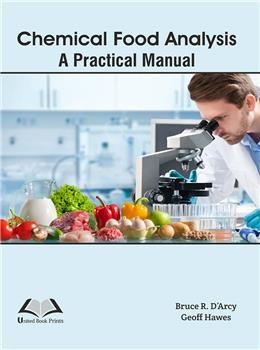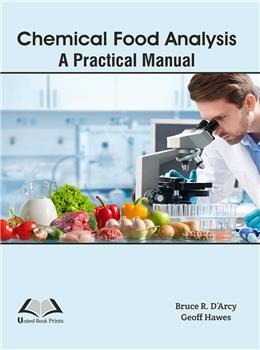Chemical Food Analysis: A Practical Manual
Chemical Food Analysis: A Practical Manual is backordered and will ship as soon as it is back in stock.
Couldn't load pickup availability
Genuine Products Guarantee
Genuine Products Guarantee
We guarantee 100% genuine products, and if proven otherwise, we will compensate you with 10 times the product's cost.
Delivery and Shipping
Delivery and Shipping
Products are generally ready for dispatch within 1 day and typically reach you in 3 to 5 days.
Book Details
-
Authors: Bruce R. D'Arcy & Geoff Hawes
-
Publisher: United Book Prints
-
Language: English
-
Edition: 1st Edition, 2022
-
ISBN: 9789388399470
-
Binding: Hardcover
-
Pages: 65
-
Size: 8.02 x 11.50 x 0.50 inches
-
Weight: 350 grams
-
Book Type: Reference Book
About the Book
This reference book provides an in-depth exploration of various analytical techniques and methods commonly used in food and beverage analysis. Designed for students, researchers, and professionals in food science and technology, it covers a wide range of analytical processes used to determine the composition, quality, and safety of food products.
Key Topics Covered Include:
-
Determination of Hydroxymethylfurfural in Honey
A detailed guide to measuring hydroxymethylfurfural (HMF) levels in honey, a key indicator of honey quality. -
Diastatic Activity of Honey
Explains the methods used to measure the enzymatic activity in honey, particularly the diastatic activity, which is crucial for assessing honey quality. -
Introduction to Advanced Capillary Gas Chromatography (GC)
An introduction to advanced GC techniques for the analysis of volatile compounds in foods and beverages. -
Metal Analysis of Foods Using Atomic Absorption Spectroscopy
Focuses on the use of atomic absorption spectroscopy (AAS) for detecting metals in food, an important technique for food safety and quality control. -
Gas Chromatography (GC) of Alcohol Content of Beverages
Describes the application of gas chromatography to measure alcohol content in beverages, ensuring compliance with regulations. -
High-Performance Liquid Chromatography (HPLC) of Sugars
Explains the use of HPLC to quantify sugars in food products, vital for nutritional labeling and food quality analysis. -
Thin Layer Chromatography (TLC) of Food Colours
Introduces TLC as a method to identify and quantify food colorants, essential for food safety and regulatory compliance. -
Titratable Acidity in Foods Using a Potentiometric Titration
Discusses the measurement of titratable acidity in foods, which is a key parameter for food preservation and quality. -
Quantification of Caffeine in Coffee/Cola Soft Drinks by HPLC
A guide to measuring caffeine levels in beverages using HPLC, an important aspect of beverage quality control. -
Column Chromatographic Separation of Plant Pigments
Covers column chromatography techniques for separating and analyzing plant pigments, relevant for food colorant analysis.
Appendix:
-
Care and Use of pH Meters
A helpful appendix providing guidance on the proper care and use of pH meters, an essential tool in food analysis.
Key Features:
-
Focus on practical applications of analytical techniques in food and beverage analysis.
-
Covers essential methods used in food science, including chromatography, spectroscopy, and titration.
-
Designed for both students and professionals in food science, chemistry, and related fields.
-
Includes clear instructions on using laboratory equipment and techniques for food quality control.
This book serves as a valuable resource for those seeking to understand the science behind food analysis, from beginners to advanced researchers.





